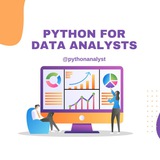📈 Predictive Modeling for Future Stock Prices in Python: A Step-by-Step Guide
The process of building a stock price prediction model using Python.
1. Import required modules
2. Obtaining historical data on stock prices
3. Selection of features.
4. Definition of features and target variable
5. Preparing data for training
6. Separation of data into training and test sets
7. Building and training the model
8. Making forecasts
9. Trading Strategy Testing
The process of building a stock price prediction model using Python.
1. Import required modules
2. Obtaining historical data on stock prices
3. Selection of features.
4. Definition of features and target variable
5. Preparing data for training
6. Separation of data into training and test sets
7. Building and training the model
8. Making forecasts
9. Trading Strategy Testing
👍22❤10👏1
Python for Data Analysis Free Resources:
Free Course: https://www.freecodecamp.org/learn/data-analysis-with-python/
Practice: https://www.kaggle.com/learn/python
Free Course: https://www.freecodecamp.org/learn/data-analysis-with-python/
Practice: https://www.kaggle.com/learn/python
👍18❤14
Python Data Science Handbook
Python Data Science Handbook: full text in Jupyter Notebooks. This repository contains the entire Python Data Science Handbook, in the form of (free!) Jupyter notebooks.
Creator: Jake Vanderplas
Stars⭐️: 39k
Fork: 17.1K
Repo: https://github.com/jakevdp/PythonDataScienceHandbook
For more, join https://t.iss.one/pythonanalyst
Python Data Science Handbook: full text in Jupyter Notebooks. This repository contains the entire Python Data Science Handbook, in the form of (free!) Jupyter notebooks.
Creator: Jake Vanderplas
Stars⭐️: 39k
Fork: 17.1K
Repo: https://github.com/jakevdp/PythonDataScienceHandbook
For more, join https://t.iss.one/pythonanalyst
👍11❤4🥰1
Which of the following is/are immutable in Python?
Anonymous Quiz
55%
Tuples
10%
Dictionaries
8%
Sets
26%
All the above
👍15❤5
Profound Python Libraries.epub
1.5 MB
Profound Python Libraries
Onder Teker, 2022
Onder Teker, 2022
20 Python Libraries You Aren't Using (But Should).pdf
4.1 MB
20 Python Libraries You
Aren’t Using (But Should)
Caleb Hattingh, 2016
Aren’t Using (But Should)
Caleb Hattingh, 2016
👏9👍7
Learning Professional Python✅
https://www.linkedin.com/posts/sql-analysts_learn-python-activity-7129340888232714240-ZuMM
Like for more 👍❤️
https://www.linkedin.com/posts/sql-analysts_learn-python-activity-7129340888232714240-ZuMM
Like for more 👍❤️
👍5
Python Interview Questions for data analyst interview
Question 1: Find the top 5 dates when the percentage change in Company A's stock price was the highest.
Question 2: Calculate the annualized volatility of Company B's stock price. (Hint: Annualized volatility is the standard deviation of daily returns multiplied by the square root of the number of trading days in a year.)
Question 3: Identify the longest streaks of consecutive days when the stock price of Company A was either increasing or decreasing continuously.
Question 4: Create a new column that represents the cumulative returns of Company A's stock price over the year.
Question 5: Calculate the 7-day rolling average of both Company A's and Company B's stock prices and find the date when the two rolling averages were closest to each other.
Question 6: Create a new DataFrame that contains only the dates when Company A's stock price was above its 50-day moving average, and Company B's stock price was below its 50-day moving average
Question 1: Find the top 5 dates when the percentage change in Company A's stock price was the highest.
Question 2: Calculate the annualized volatility of Company B's stock price. (Hint: Annualized volatility is the standard deviation of daily returns multiplied by the square root of the number of trading days in a year.)
Question 3: Identify the longest streaks of consecutive days when the stock price of Company A was either increasing or decreasing continuously.
Question 4: Create a new column that represents the cumulative returns of Company A's stock price over the year.
Question 5: Calculate the 7-day rolling average of both Company A's and Company B's stock prices and find the date when the two rolling averages were closest to each other.
Question 6: Create a new DataFrame that contains only the dates when Company A's stock price was above its 50-day moving average, and Company B's stock price was below its 50-day moving average
👍15❤5
